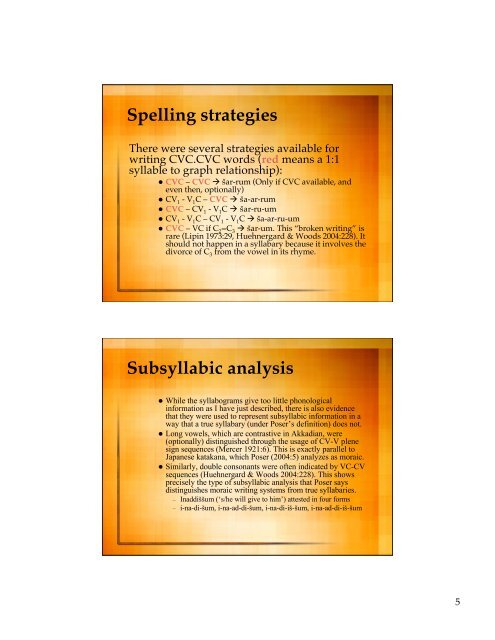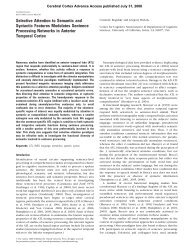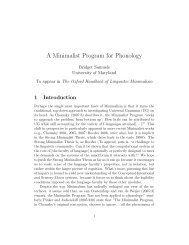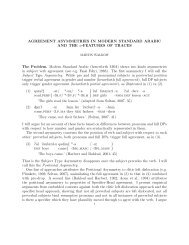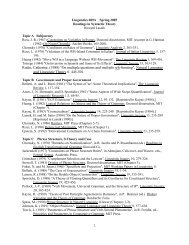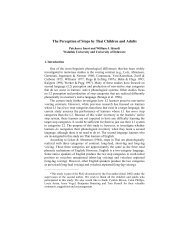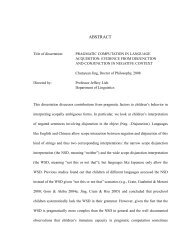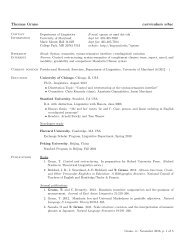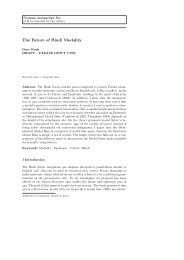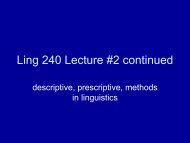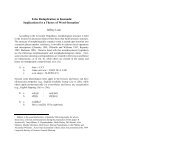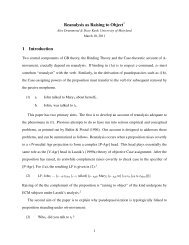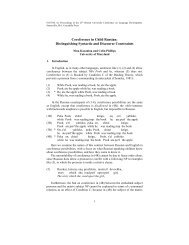Phonological Representation in Akkadian Orthography
Phonological Representation in Akkadian Orthography
Phonological Representation in Akkadian Orthography
Create successful ePaper yourself
Turn your PDF publications into a flip-book with our unique Google optimized e-Paper software.
Spell<strong>in</strong>g strategies<br />
There were several strategies available for<br />
writ<strong>in</strong>g CVC.CVC words (red means a 1:1<br />
syllable to graph relationship):<br />
CVC – CVC šar-rum (Only if CVC available, and<br />
even then, optionally)<br />
CV 1 - V 1C – CVC ša-ar-rum<br />
CVC – CV 1 - V 1C šar-ru-um<br />
CV 1 - V 1C – CV 1 - V 1C ša-ar-ru-um<br />
CVC – VC if C 2=C 3 šar-um. This “broken writ<strong>in</strong>g” is<br />
rare (Lip<strong>in</strong> 1973:29, Huehnergard & Woods 2004:228). It<br />
should not happen <strong>in</strong> a syllabary because it <strong>in</strong>volves the<br />
divorce of C 3 from the vowel <strong>in</strong> its rhyme.<br />
Subsyllabic analysis<br />
While the syllabograms give too little phonological<br />
<strong>in</strong>formation as I have just described, there is also evidence<br />
that they were used to represent subsyllabic <strong>in</strong>formation <strong>in</strong> a<br />
way that a true syllabary (under Poser’s def<strong>in</strong>ition) does not.<br />
Long vowels, which are contrastive <strong>in</strong> <strong>Akkadian</strong>, were<br />
(optionally) dist<strong>in</strong>guished through the usage of CV-V plene<br />
sign sequences (Mercer 1921:6). This is exactly parallel to<br />
Japanese katakana, which Poser (2004:5) analyzes as moraic.<br />
Similarly, double consonants were often <strong>in</strong>dicated by VC-CV<br />
sequences (Huehnergard & Woods 2004:228). This shows<br />
precisely the type of subsyllabic analysis that Poser says<br />
dist<strong>in</strong>guishes moraic writ<strong>in</strong>g systems from true syllabaries.<br />
– Inaddiššum (‘s/he will give to him’) attested <strong>in</strong> four forms<br />
– i-na-di-šum, i-na-ad-di-šum, i-na-di-iš-šum, i-na-ad-di-iš-šum<br />
5


